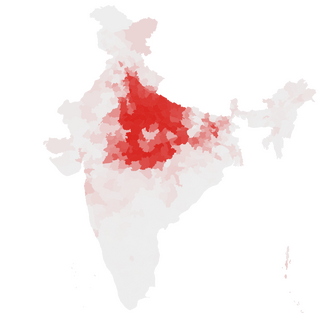Hindi
Hindi (Devanagari: हिन्दी, हिंदी, ISO: Hindī), or more precisely Modern Standard Hindi (Devanagari: मानक हिन्दी, ISO: Mānaka Hindī), is an Indo-Aryan language spoken chiefly in the Hindi Belt region encompassing parts of northern, central, eastern and western India. Hindi has been described as a standardised and Sanskritised register[9] of the Hindustani language, which itself is based primarily on the Khariboli dialect of Delhi and neighbouring areas of Northern India. Hindi, written in the Devanagari script, is one of the two official languages of the Government of India, along with English. It is an official language in 9 States and 3 Union Territories and an additional official language in 3 other states.Hindi is also one of the 22 scheduled languages of the Republic of India.

| Pronunciation | Hindi |
| Region | Northern, Eastern, Western and Central India (Hindi Belt) |
| Native speakers | L1 speakers: 322 million speakers of Hindi and various related languages reported their language as 'Hindi' (2011 census)
L2 speakers: 270 million (2016) |
| Early forms | Shauraseni Prakrit
Sauraseni Apabhramsa Old Hindi Hindustani |
| Writing system | Devanagari (official)
Kaithi (historical) Mahajani (historical) Laṇḍā (historical)[4] Roman (unofficial) Devanagari Braille |
| Signed forms | Signed Hindi |
| Official language in | 🇮🇳 India |
| Recognised minority language in | 🇿🇦South Africa
🇦🇪 United Arab Emirates |

Hindi is the lingua franca of the Hindi Belt. It is also spoken, to a lesser extent, in other parts of India (usually in a simplified or pidginised variety such as Bazaar Hindustani or Haflong Hindi). Outside India, several other languages are recognised officially as "Hindi" but do not refer to the Standard Hindi language described here and instead descend from other dialects, such as Awadhi and Bhojpuri. Such languages include Fiji Hindi, which has an official status in Fiji, and Caribbean Hindustani, which is spoken in Trinidad and Tobago, Guyana, and Suriname. Apart from the script and formal vocabulary, standard Hindi is mutually intelligible with standard Urdu, another recognised register of Hindustani as both share a common colloquial base.
As a linguistic variety, Hindi is the fourth most-spoken first language in the world, after Mandarin, Spanish and English. Hindi alongside Urdu as Hindustani is the third most-spoken language in the world, after Mandarin and English.
Etymology
The term Hindī originally was used to refer to inhabitants of the Indo-Gangetic Plain. It was borrowed from Classical Persian هندی Hindī (Iranian Persian pronunciation: Hendi), meaning "of or belonging to Hind (India)" (hence, "Indian").
Another name Hindavī (हिन्दवी) or Hinduī (हिन्दुई) (from Persian: هندوی "of or belonging to the Hindu/Indian people") was often used in the past, for example by Amir Khusrow in his poetry.
The terms "Hindi" and "Hindu" trace back to Old Persian which derived these names from the Sanskrit name Sindhu (सिन्धु ), referring to the river Indus. The Greek cognates of the same terms are "Indus" (for the river) and "India" (for the land of the river).
History
Middle Indo-Aryan to Hindi
Like other Indo-Aryan languages, Hindi is a direct descendant of an early form of Vedic Sanskrit, through Sauraseni Prakrit and Śauraseni Apabhraṃśa (from Sanskrit apabhraṃśa "corrupt"), which emerged in the 7th century CE.
The sound changes that characterised the transition from Middle Indo-Aryan to Hindi are:
- Compensatory lengthening of vowels preceding geminate consonants, sometimes with spontaneous nasalisation: Skt. hasta "hand" > Pkt. hattha > hāth
- Loss of all word-final vowels: rātri "night" > rattī > rāt
- Formation of nasalised long vowels from nasal consonants (-VNC- > -V̄̃C-): bandha "bond" > bā̃dh
- Collapsing of adjacent vowels (including separated by a hiatus: apara "other" > avara > aur
Hindustani
During the period of Delhi Sultanate, which covered most of today's India, eastern Pakistan, southern Nepal and Bangladesh and which resulted in the contact of Hindu and Muslim cultures, the Sanskrit and Prakrit base of Old Hindi became enriched with loanwords from Persian, evolving into the present form of Hindustani. The Hindustani vernacular became an expression of Indian national unity during the Indian Independence movement, and continues to be spoken as the common language of the people of the northern Indian subcontinent, which is reflected in the Hindustani vocabulary of Bollywood films and songs.
External links
See also
References
Back to Jat Languages

